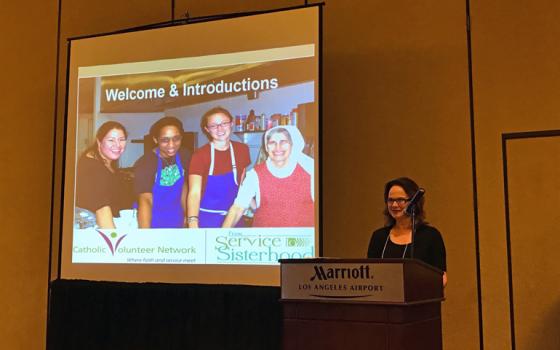With the decline in numbers of women joining vocations, congregations of women religious have had to get creative with their outreach efforts. For many communities, service has been their answer.
Women religious' involvement in volunteer and service programs is not new. Women religious sponsor 23 percent of all service programs involved in the Catholic Volunteer Network, "one of the leading membership organizations for Christian volunteer and mission programs" according to its website. What is new is the effort to fund additional women religious' volunteer programs that emphasize discernment.
Volunteering has already been a fertile ground for the transition to religious life. In 2013 the Center for Applied Research in the Apostolate at Georgetown University released the results of a study commissioned by the Catholic Volunteer Network to explore a variety of topics. The study, titled Volunteer Introspective, surveyed more than 5000 former volunteers from the CVN.
One of the significant findings involved vocations. The survey showed that almost two out of five volunteers have considered a vocation to ordained ministry or religious life. Of those who considered a religious vocation, 48 percent did so during their volunteer service.
It wasn't a fleeting idea -- 62 percent of the volunteers who answered that they've considered a vocation to ordained ministry or religious life said they have "very seriously" or "somewhat seriously" thought about it.
Taking notice of these results, the Conrad N. Hilton Foundation, which has a special focus on increasing the number of Catholic sisters in the United States, recognized that the Catholic Volunteer Network could indicate a potential new avenue to reach out to young women who may be interested in becoming a sister.
In response, the foundation started the "From Service to Sisterhood" partnership with the Catholic Volunteer Network. The three-year initiative, which began in 2013, "seeks to strengthen the vitality of the congregations of women religious through the development of volunteer programs," according to the From Service to Sisterhood page on the CVN website.
"This is a real visionary grant. ... This is probably one of our more innovative grants," Kara Lemme, program officer of the Catholic Sisters Initiative at the Conrad N. Hilton Foundation, told GSR. "It's a great leveraging strategy to test and we're testing it," said School Sr. of Notre Dame Rosemarie Nassif, director of the Catholic Sisters Initiative at the Conrad N. Hilton Foundation. The Hilton Foundation also funds the Global Sisters Report.
A pre-conference event about the From Service to Sisterhood initiative took place Nov. 10 in Los Angeles, as an extension of the Catholic Volunteer Network's National Conference on Faith-Based Service. There, volunteer groups and vocational teams gathered to discuss best practices about broaching the subject of vocations during service.
Many participants pointed out that the goal was not to get women to join religious life but rather to introduce religious life to young adults who may not have had exposure to these communities or women before.
"A lot of women, because we're not always as visible to young adults either by our ministry or because of our dress, they really have no idea what religious life and Catholic sisters are," said Mary Catherine Redmond, a sister of the Presentation of the Blessed Virgin Mary and a team member of the Serving with the Sisters volunteer program, in an interview with GSR.
Redmond remarked that the short-term volunteer program includes placements that are modeled after the sisters' apostolic ministry in religious life. This includes a volunteer position helping sisters located at the United Nations and has given the women volunteers a "wonderful insight to religious life," according to Redmond.
Part of the partnership between the CVN and the Conrad N. Hilton Foundation has included offering funding to congregations of women religious who want to start their own volunteer program. Redmond's congregation was one of the 16 congregations who received the first round of grants in 2014.
The Benedictine Volunteers was also a 2014 recipient. Program director Patricia Nguyen spoke at the pre-conference about the program, which is 50 percent service in one of many placements, including healthcare, poverty alleviation and liturgical minsitries, and 50 percent discernment. "Our ideal applicant is generally interested in service," said Nguyen when speaking to GSR. Another important part of the interview process is seeing where is the applicant's "sense of call." Nguyen was clear that the program was for discernment in all aspects of a volunteer's life and not solely for vocations.
Nguyen's program is unique in that the Benedictine sisters are a monastic community. "The volunteers, they come with certain stereotypes about monastic life and then they come to love it," said Nguyen. So far, in the two years the program has been around, Nguyen has had two women discerning religious life, equaling to half of all of their volunteers so far.
Katie Mulembe, the manager of outreach and engagement for CVN, presented on some preliminary results of the partnership. Mulembe said that from the 16 volunteer programs that received the initial funding, there have been 276 total volunteers in three years. Out of those 276 volunteers, 28 have expressed interest in religious life and 111 have expressed interest in staying connected with the sisters.
While some women are already reporting an interest in religious life, it is difficult to know if that will result in an increase in the number of women religious. "It's not an impact we're going to see in three years," Nassif told GSR about the From Service to Sisterhood initiative's direct impact on vocational enrollment. "I think we're seeing success more broadly."
The program has helped change some of the stereotypes surrounding women religious and break down "barriers of vocational discernment," based on some of the responses from volunteers, Mulembe said.
Volunteers in the Vincentian Service Corps West mainly serve in sponsored ministries of the Daughters of Charity doing health care, education and social services in Los Angeles, San Jose, and San Francisco, Calif. Working alongside sisters is a way to have the communities' charism — "given to God, in Community, for the service of those who are poor" as stated on its website, "flow" from the sisters to the volunteers, said Daughter of Charity Sr. Frances Vista, who is also executive director of the Vincentian Service Corps West.
She currently has three volunteers who are discerning a call to the religious life, and has had many former volunteers who are now or in the process of becoming priests and religious sisters.
Women religious are also seeing direct benefits from the initiative. During the pre-conference, Mulembe reported that out of the 16 communities that received a grant from the "From Service to Sisterhood Initiative," there has been a 100 percent increase in religious community engagement and that 60 percent of the groups have experienced new inquiries for membership.
In addition, more than 80 percent said the volunteer programs brought new life to their ministries.
Both Nguyen and Redmond have personally seen the benefits that volunteers can offer to the religious communities themselves. Due to an aging population, the Benedictine sisters have more recently had to adapt from apostolic ministry to a monastic lifestyle. To fill those gaps left by the sisters, Nguyen's group of volunteers have become the "hospitality ambassadors" to the communities the sisters used to serve in.
Communities are also getting more involved with the volunteers. Each week a Benedictine volunteer is assigned a new "hospitality companion," a sister within the community who signs up with the intent to get to know the volunteer through meals, prayer and planned activities.
In the Serving with the Sisters volunteer program, Redmond said that sisters were invited to join the volunteers when they were building a house. The average age of the sisters who came to help was 70 years old. The enthusiasm of the sisters encouraged the program to invite the sisters to be more involved within the program and the volunteers.
Initially some sisters were intimidated by the young adult women, Redmond said, but soon realized that they "don't need something extra to connect with young adults," just their "presence and everybody has that."
After the success of the short-term program, Redmond and the community hope to eventually offer long-term service placements. "What this grant has done for our congregation is phenomenal. It's totally renewed our mission ... [and given us] experience with young adults we never would have had," said Redmond.
[Kristen Whitney Daniels in an NCR Bertelsen editorial intern. Her email address is [email protected].]

